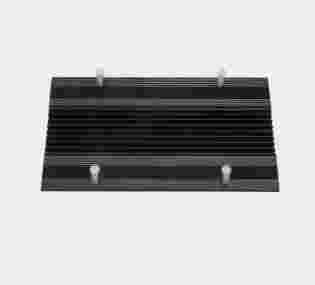An In-Depth Analysis of the Thermal Performance Characteristics of Aluminum Profile Heatsinks

The thermal performance of the aluminum profile heatsink plays a pivotal role in the efficient functioning of electronic devices. As technology advances, the need for effective cooling solutions has become more critical than ever. Aluminum profile heatsinks, with their unique properties and construction, have emerged as a popular choice for heat dissipation in various applications. This article delves into the factors that contribute to the thermal performance of aluminum profile heatsinks and how they compare to other materials in the market.
Aluminum, being a lightweight metal with excellent thermal conductivity, is often the material of choice for heatsink profiles. The ability of aluminum to conduct heat away from the source quickly and efficiently makes it an ideal candidate for heat dissipation applications. The performance of an aluminum profile heatsink is influenced by several factors, including its geometry, surface area, and the quality of the aluminum used.
One of the primary advantages of aluminum profile heatsinks is their high thermal conductivity, which allows them to draw heat away from components effectively. This thermal conductivity, combined with the lightweight nature of aluminum, makes these heatsinks ideal for applications where weight is a concern, such as in aerospace or portable electronics. The lightweight nature of aluminum also contributes to its ease of manufacturing and the ability to create complex shapes that can enhance heat dissipation.
The geometry of an aluminum profile heatsink is another critical factor in its thermal performance. Fins, for instance, are commonly used to increase the surface area of the heatsink, allowing for greater heat dissipation. The design of these fins, including their size, density, and shape, directly impacts the efficiency of heat transfer. Aluminum's malleability enables the creation of intricate fin designs that can optimize heat transfer without adding excessive weight.
Surface treatments also play a significant role in the thermal performance of aluminum profile heatsinks. Anodizing, for example, is a popular treatment that enhances the durability and corrosion resistance of aluminum, which can be beneficial in environments with high humidity or where the heatsink may be exposed to harsh chemicals. This process can also improve the heatsink's ability to bond with thermal interface materials, further enhancing heat transfer.
Another aspect of thermal performance is the compatibility of the aluminum profile heatsink with the surrounding components. Aluminum's coefficient of thermal expansion is close to that of many plastics and some semiconductor materials, which reduces the risk of damage due to thermal stress. This compatibility is crucial in maintaining the integrity of the electronic components and the heatsink over time.
However, it's important to note that while aluminum profile heatsinks offer many advantages, they may not always be the best solution for every application. For instance, copper, which has a higher thermal conductivity than aluminum, may be preferred in scenarios where the most efficient heat dissipation is required, despite its higher cost and weight.
In conclusion, the thermal performance of aluminum profile heatsinks is a result of a combination of factors, including the material's inherent properties, the design of the heatsink, and the surface treatments applied. While aluminum offers a balance of thermal conductivity, lightweight construction, and cost-effectiveness, the specific requirements of an application will dictate the most suitable heatsink material and design. As technology continues to evolve, the development of new materials and surface treatments will likely further enhance the performance of aluminum profile heatsinks, ensuring their continued relevance in the field of thermal management.
Material: AL 6063 T5
Production Process: Profiles Extruding---Cutting---CNC Machining(Milling, Drilling,Tapping)---Deburring--- Cleaning--- Inspecting--Packing
Surface Treatment: Degreasing,(Black) Anodizing, Sand Blasting, Painting, Chromating and Laser marking.
Experience: More than 20 years of professional manufacturing experience
Application: LED Lighting, Inverter, Welding Machine, Communication Device, Power Supply Equipment, Electronic Industry, Thermoelectric Coolers/Generator, IGBT/UPS Cooling Systems, etc.
- Whats New
- Shopping
- Wellness
- Sports
- Theater
- Religion
- Party
- Networking
- Music
- Literature
- Art
- Health
- Games
- Food
- Drinks
- Fitness
- Gardening
- Dance
- Causes
- Film
- Crafts
- Other/General
- Cricket
- Grooming
- Technology

